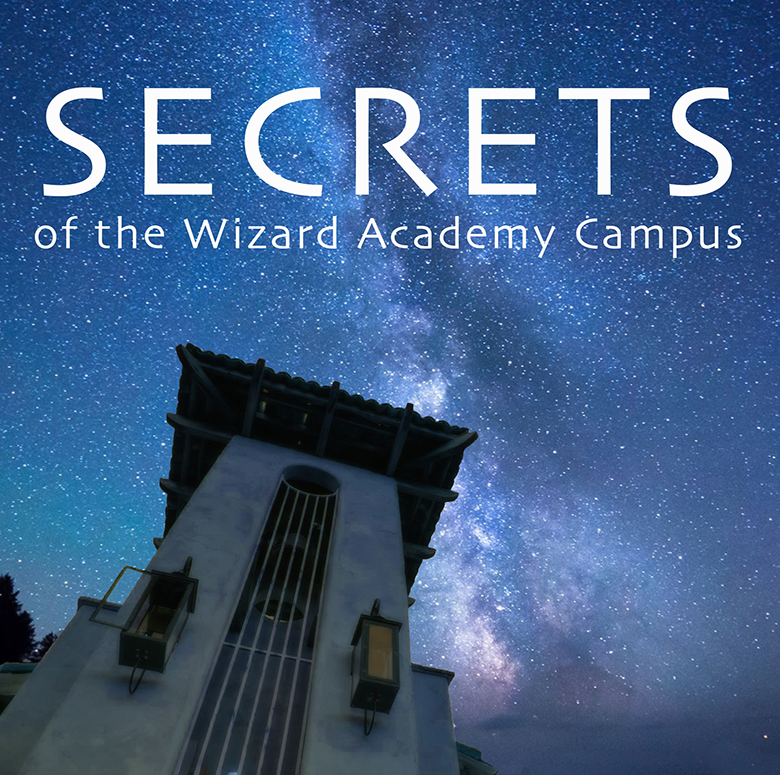
FOREWORD: WHO WE ARE AND WHAT WE TEACH
1. A LANGUAGE OF ARCHITECTURE
2. GO UP FOR CELEBRATION. GO DOWN TO FIND DEPTH OF MEANING.
3. THE TOWER (STUDENTS ONLY INSIDE)
4. WALKING TO CHAPEL DULCINEA
5. CHAPEL DULCINEA
6. EXPLANATION POINT, AND MY HEART IS IN YOUR HANDS
7. ON THE OTHER SIDE OF THE BELL WALL IN THE VALLEY OF THE LOST BOYS, DOWN BELOW THE CHAPEL (STUDENTS ONLY)
8. THE ENCHANTED EMPORIUM WELCOME CENTER, THE CROWDED BARREL DISTILLERY, AND THE GRAPES AND GRAIN OPEN-AIR BAR
9. ON THE EAST SIDE OF THE CAMPUS: TUSCAN HALL, TUSCAN COURT, TUSCAN TERRACE, SUNPOP STUDIOS, AND THE HOUSE OF 10 DOORS
APPENDIX
“SEEING CHRIST IN QUIXOTE”
“TAKE YOUR INSPIRATION FROM WHEREVER YOU FIND IT.”

FOREWORD: WHO WE ARE AND WHAT WE TEACH
Wizard Academy is a 501c3 Educational Organization that teaches advanced communication techniques – storytelling – to business owners, ad writers, artists, scientists and salespeople who desire to influence the thoughts, emotions, and behavior of others.
We believe the fundamental truths of science are expressed repeatedly throughout the arts. Our school exists to uncover these principles and apply them in business and in life.
The Wise Men (wise-ards) of the Christmas story believed they would find something wonderful if they followed a star. It is from these wise men that Wizard (wis-ard) Academy takes its name.
Stars represent the impossible dreams of every adventurer.
What is the dream that whispers your name? Are you ready to follow the star that beckons you? If so, you’ll find this to be a place of preparation and encouragement.
The buildings and artwork, cliffs and valleys, gardens and plazas of Wizard Academy were crafted to unleash your mind to see the bright possibilities of your future.
In an 1805 letter to George Beaumont, the poet William Wordsworth observed,
“Laying out grounds may be considered a liberal art, in some sort like poetry and painting.” 1
In 1941, the immortal John Steinbeck said,
“Places are able to evoke moods, as color and line in a picture may capture and warp us to a pattern the painter intended.” 2
The earliest example of groundskeeping as a life’s work can be found in the second chapter of the Bible’s book of Genesis.
“The Lord God took the man and put him in the Garden of Eden to work it and take care of it.” 3
But just three verses later the Lord God said,
“It is not good for the man to be alone,” and Eve became his partner in the effort. 4
Then things really began to happen. So it should come as no surprise that the campus of Wizard Academy was envisioned and built by a woman.
Perhaps we’ll meet her later.
1 In a letter to Sir George H. Beaumont, Grasmere, (Oct. 17, 1805)
2 John Steinbeck, Sea of Cortez, p. 256, (1941)
3 Genesis 2:15
4 Genesis 2:18

1. A LANGUAGE OF ARCHITECTURE
“High ceilings encourage you to think big thoughts,” is the easy way to say it, 5 but not entirely accurate.
The 253-foot ceiling of the Superdome in New Orleans is undeniably high, but its effect is mitigated by the 680-ft. width of that arena at its narrowest point.
The secret of “spatial majesty” has been known to architects since the year 301 when Etchmiadzin Cathedral was designed in Armenia: “to unleash the mind to think big thoughts, the height of the ceiling must be a greater distance from the floor than the narrowest diameter of its footprint.”
The 18-ft ceiling of Chapel Dulcinea feels majestic only because the supporting pillars beneath it define a footprint just 13 feet, 4 inches across.
In the Tower, the 24-foot ceiling above “The Eye of the Storm” feels majestic because the handrails of the catwalk suspended below the ceiling define a footprint only 16 feet across.
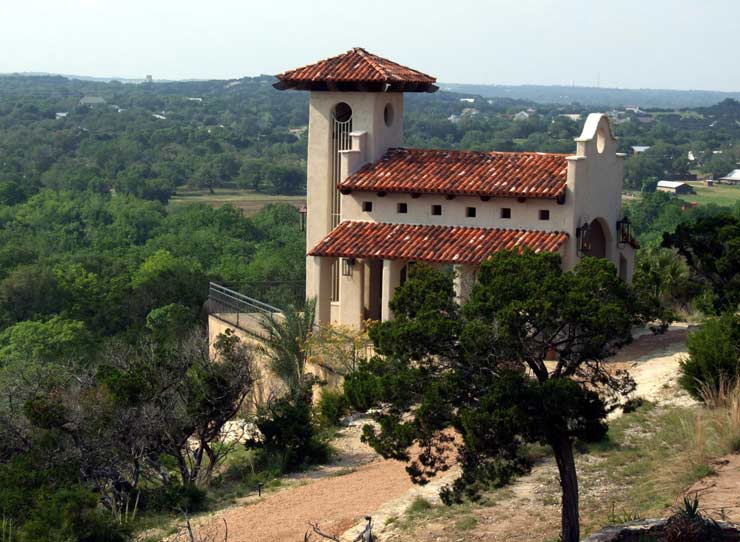
Windows, doors, walls and floors are important, of course, but when you enter a room and it feels interesting to you, look up at the ceiling and you’ll understand why.
And if you control the music, you control the mood of the room.
5 Journal of Environmental Psychology, Volume 41, March 2015, Pages 10-18. An international study led by Dr. Oshin Vartanian scanned the brains of volunteers while they looked at images of 200 rooms, half of which had high ceilings. Participants simply indicated whether each image was beautiful or not. In the fMRI scanner, the experts found that people were more likely to find spaces with high ceilings attractive, rather than those with low ceilings. They also saw that high ceilings elevated activity in two areas of the brain associated with visual exploration – the left precuneus and left middle frontal gyrus. Dr Vartanian concluded, “Rooms with high ceilings promote visuospatial exploration, while at the same time they prompt us to think more freely. This could be a rather potent combination for inducing positive feelings.”
2. GO UP FOR CELEBRATION.
GO DOWN TO FIND DEPTH OF MEANING.
On the campus of Wizard Academy, we travel upward to study and celebrate, downward to find meaning and rest.
According to Carl Jung’s theory of depth psychology, 6 life is a journey on water.
Water: that transparent portal separating the objective reality of the conscious mind from the subjective reality of the unconscious mind. Above the waterline is that hectic world of our conscious mind, filled with all the difficulties of daily life. Below the waterline is the unconscious mind, a beautiful, silent world where we feel weightless and anything is possible.
Our relationship to the unconscious mind is exactly like our relationship to water. We need it by the cupful to survive; but if we stay under too long, we risk a psychotic break; yes, there are monsters in the deep.
But a brief plunge into the waters of the unconscious is stimulating. We are refreshed each time we submerge ourselves into “the arts.”
The arts communicate to the unconscious mind through:
- the visual languages of color, motion, shape, proximity, and radiance,
- the abstract languages of symbol and simile and metaphor, and
- the auditory languages of pitch, key, tempo, contour, interval, rhythm, and phonemes.
Waterlines – both real and implied – are important symbols on the campus of Wizard Academy. We will examine a few of these waterlines throughout the book.8
6 cgjungcenter.org tells us that depth psychology includes “therapeutic traditions that explore the unconscious and involve the study and exploration of dreams, complexes, and archetypes. Depth psychology is non-pathologizing and strength affirming.”
7 In Jungian depth psychology, the animus is the perfect man that lives in the mind of a woman, and the anima is the perfect woman that lives in the mind of a man. The four faces of the animus are the masculine archetypes: King, Healer, Warrior, and Wizard. The four faces of the anima are the feminine archetypes: Mother (Eve,) Lover (Helen of Troy,) Strong Woman (Mary, mother of Jesus) and Mystic (Sophia, a man’s guide to his inner life.) Perfectly aligned at the south/north terminus points of the lower path to the tower, The Old Man and the Sea and Into the Wind speak of the Warrior and the Strong Woman archetypes.
8 Additional waterlines are discussed in
Chap. 2 “The Laughlin Stone”
Chap. 7 “The Fountain at Engelbrecht House” and
Chap. 10 “Tuscan Hall”

We’ll examine the first waterline by approaching the tower from the south.
Do you see THE THINKER at the edge of the parking lot? Follow that sidewalk and you’ll find:
THE OLD MAN AND THE SEA, by Jane DeDecker,
“He was an old man who fished alone in a skiff in the Gulf Stream and he had gone eighty-four days now without taking a fish.”
– Ernest Hemingway, opening line of The Old Man and the Sea, (1952)
“‘The fish is my friend too,’ he said aloud. ‘I have never seen or heard of such a fish. But I must kill him. I’m glad we do not have to kill the stars.'”
– The old man Santiago in The Old Man and the Sea
“No good book has ever been written that has in it symbols arrived at beforehand and stuck in. I tried to make a real old man, a real boy, a real sea and a real fish and real sharks. But if I made them good and true enough they would mean many things.”
– Ernest Hemingway, speaking of The Old Man and the Sea, for which he won the 1953 Nobel Prize in Literature

Wizard Academy’s life-size representation of the warrior archetype is Ernest Hemingway’s old man, Santiago, as he drags the skeleton of his 18-foot marlin onto the beach. In the book, he is bleeding from the lash of the rope across his back and his hands are bleeding from the wounds he suffered as he fought a great monster from the deep for 3 days and 3 nights.
Sound familiar?
Santiago was victorious, of course.
But then the sharks came.
THE TWIN LIONS, FINCHER & OZMENT
greet you at the halfway point between Hemingway’s Old Man and the Sea and the Tower.
As you approach Fincher and Ozment, you are invited to step into the bronze footprints of:
THE LAUGHLIN STONE
See that bronze plaque with the footprints near Fincher and Ozment?
See the hilt of the sword extending from the battlement at the top of the Tower? Place your feet in those footprints at any hour on a clear night and you will see the North Star – Polaris – hovering just above the hilt of that sword. We’ll talk more about this when we get to the chapter about the Star Deck of the Tower.
Walking due north from THE OLD MAN AND THE SEA toward INTO THE WIND, we move from the beach of Santiago into an ever-deepening ocean. Standing beneath the ship of INTO THE WIND, we are now 12 feet below the surface of that invisible water on which she sails.
The art gallery and the wine cellar are behind that door in front of you.
But of course.
Because art and wine both speak to the unconscious mind.

THE ANIMA AND THE ANIMUS
A principal archetype of the masculine unconscious is the anima; the perfect woman that exists only in the mind of a man. 7
You will find numerous examples of the anima throughout our campus.
DULCINEA, the Wedding Chapel.
THE SPIRIT OF ECSTACY in the Welcome Center.
GRACILLA, in the garden of Joy.
THE BROKEN ANGELS of Engelbrecht House.
GARDENIA, guardian of the garden at Tuscan Court,
MY HEART IS IN YOUR HANDS, past Chapel Dulcinea,
INTO THE WIND, on the plaza of the Tower.
Leaning forward over the prow of her ship, chin up and shoulders back, INTO THE WIND, by Jane DeDecker represents the quiet determination of strong women.
Lorian Hemingway talks about the quiet determination of a strong woman:
“At the age of thirty-five Freda had had a mastectomy. The bow and arrow was her therapy, to strengthen what was left of her chest muscles. Her body had been perfect, a sculptor’s model, and she’d worn her summer shirts tied up high under her breasts, braless most of the time. She still wore her shirts knotted at the rib cage, but now they were men’s cotton pajama tops, the material thicker so you could not see through; but often when she bent forward I could see the scarred bony place where the breast had been. I never knew if she was bitter for the loss, if she stared at the deformity in the mirror and wished for a time when she’d been whole. She never said. I never asked. She was not a woman martyred by tragedy, nor was she at all acquainted with self-pity.”
– Lorian Hemingway, Walk on Water, p. 38
“Freda was a dazzle, a virtual watercolor of a woman whose moods and mannerisms were as electric as her wild black hair. Her grin alone, a flash of Ipana-white teeth, head tossed back, stopped men in their tracks, delayed them in traffic, and threatened their wives so completely even the milkman was not allowed to deliver at Freda’s house.”
– Lorian Hemingway, Walk on Water, p. 39

3. THE TOWER
is balanced on the pinnacle of the Balcones Escarpment 9 900 feet above the city of Austin. From the Star Deck of the Tower, you can look down at the skyline of that beautiful city 21 miles away.
The interior of the tower is open only to students of Wizard Academy who are currently enrolled in a class.
The upper approach to the tower begins on the path that leads to Chapel Dulcinea.
When you see the bronze plaque identifying
THE BROTHERS OF THE MUDD,
turn right, then back to the left and walk up that ramp to the upper sidewalk. You’ll travel only a dozen steps toward the Tower before you see:
CHILDREN ON A BIKE RIDE
by Jane DeDecker, symbolizing the curiosity, generosity, and self-determination we see in every student who is attracted to this place.
9 The Balcones Escarpment is the plateau that separates the high desert of West Texas from the long, smooth decline of East Texas that slopes down to the Gulf of Mexico.

THE STANDING STONE
At the northwest corner of the Tower Plaza you’ll find a vertical stone shaped like an arrowhead, 34-inches tall, that someone placed there many years ago, probably to channel the energy of the hilltop. 10
We discovered that stone on March 29, 2004, the day Princess Pennie purchased the acreage on which Wizard Academy now stands. She and I had been searching through the trees and underbrush to find the pinnacle of the plateau when there it was…
We decided to build the Tower alongside it.
When we mentioned that stone to our real-estate agent, Dennis Wagner, he purchased and installed the metal canopy above it as a gift to Wizard Academy.
10 The explanation about channeling the energy of the hilltop was offered to us by one of our neighbors from the Hindu temple to the north.
ART GALLERY OF THE TOWER
houses a portion of the Quixote collection of Roy and Pennie Williams gathered from around the world for more than 20 years.
In the center of the art gallery is a bronze sculpture of the Crucifixion of Christ 11 by Juan Gastelum called FIGHTING GIANTS. When Pennie chose to display it on a tall, glass table, she didn’t anticipate the shadow it would cast below. That bronze sculpture of “Quixote in the Hand of the Giant” casts a shadow on the floor of “Quixote on the Arms of the Windmill,” which is, itself, a shadow of Christ on the cross.
Serendipity is an amazing thing, isn’t it?
11 The evidence that suggests Miguel de Cervantes created Don Quixote as a figure of Christ, the Windmill as a type of cross, Dulcinea as a figure of the Church, and Sancho Panza as a figure of doubting humanity, can be found in the appendix of this book under the title, “Seeing Christ in Quixote.”
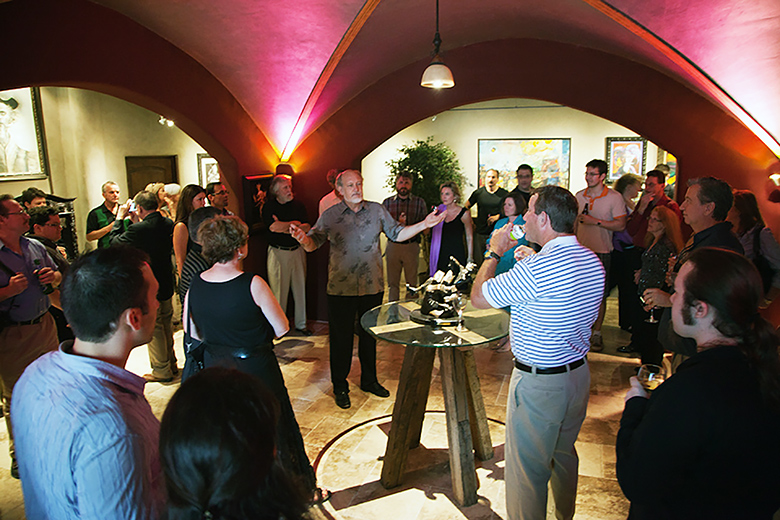
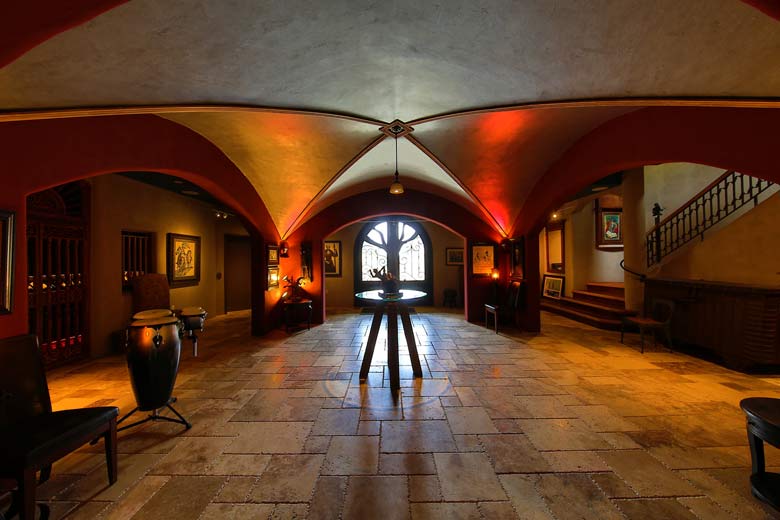
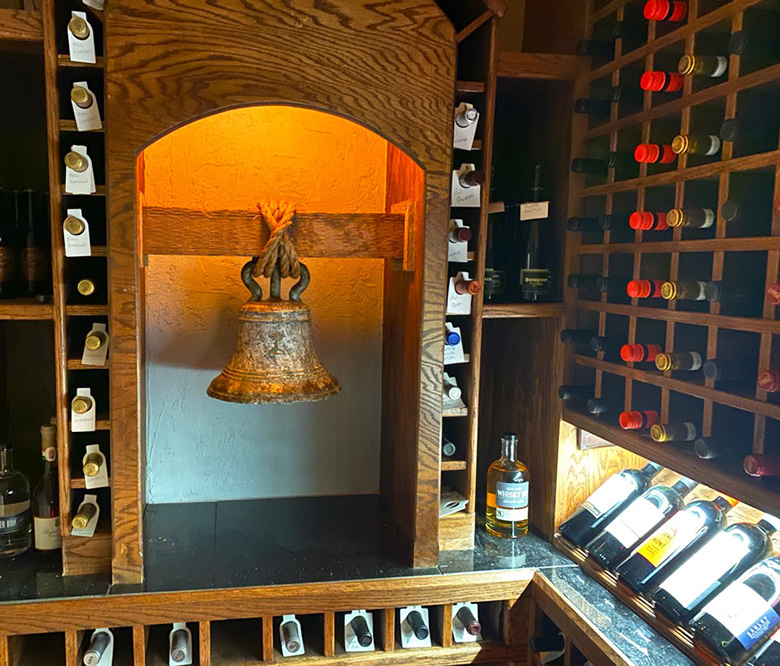
WINE CELLAR OF THE TOWER
On the third day, there was a wedding in Cana of Galilee, and the mother of Jesus was there. Now both Jesus and his disciples were invited to the wedding. And when they ran out of wine, the mother of Jesus said to Him,
“They have no wine.”
Jesus said to her,
“Woman, what does your concern have to do with me? My hour has not yet come.”
His mother said to the servants, “Whatever He says to you, do it.”
Now there were set there six waterpots of stone, according to the manner of purification of the Jews, containing twenty or thirty gallons apiece. Jesus said to them,
“Fill the waterpots with water.”
And they filled them up to the brim. And He said to them, “Draw some out now, and take it to the master of the feast.”
And they took it. When the master of the feast had tasted the water that was made wine, and did not know where it came from (but the servants who had drawn the water knew), the master of the feast called the bridegroom. And he said to him,
“Every man at the beginning sets out the good wine, and when the guests have well drunk, then the inferior. You have kept the good wine until now!”
This beginning of signs Jesus did in Cana of Galilee, and manifested His glory; and His disciples believed in Him.
– John’s Gospel, chapter 2
Weddings and wine were important to Jesus and his mom.
‘Nuff said.
“Wine is bottled poetry.”
– Robert Louis Stevenson,
author of Treasure Island

BANQUET HALL OF THE TOWER
The students of Wizard Academy enjoy their meals in a banquet hall worthy of King Arthur’s Camelot. Its gigantic iron doors and over-tall windows would seem to indicate this place was designed for giants.
And giants they are.
The students of Wizard Academy are an extraordinarily accomplished group.
THE EYE OF THE STORM IN THE TOWER
is where they learn that traditional wisdom is often more tradition than wisdom.
The moment you enter this majestic classroom and lecture hall, you realize you have stumbled into an intellectual summer camp for grown-ups.

THE WHISKEY VAULT IN THE TOWER
Walk out the side door of the Eye of the Storm and you’ll find yourself standing outdoors on the quarter deck of the Tower. That Bank Vault door over there opens up into Wizard Academy’s world-famous whiskey vault.
The vault is a resource for the students who journey through Wizard Academy’s Whiskey Marketing School. It is a sort of reference library for students who seek to earn the title, “Whiskey Sommelier.” They use the vault to help them craft enchanting whiskey-moments, weaving stories about the people, the process, and the history behind each bottle.
In 2016, Daniel Whittington and Rex Williams created a YouTube whiskey review channel that spawned a worldwide community of people called, “The Whiskey Tribe.” More than 50% of the whiskey in the vault was donated by the tribe.
It is a stunning collection of rare whiskeys.
Now walk back into the EYE OF THE STORM. Look upwards and you’ll see:

THE LIBRARY CATWALK IN THE TOWER
is stacked to the ceiling with books.
“This is a place of mystery, a sanctuary. Every book, every volume you see here, has a soul. The soul of the person who wrote it and of those who read it and lived and dreamed with it. Every time a book changes hands, every time someone runs his eyes down its pages, its spirit grows and strengthens. This place was already ancient when my father brought me here for the first time, many years ago.”
– Carlos Ruiz Zafon, Shadow of the Wind
Behind one of those bookcases is the office of the Chancellor, offering a spectacular view of the Texas hill country through an eastern-facing glass wall. It is a view of infinite possibilities.

THE HANDRAIL OF THE CATWALK IN THE TOWER
serves three important functions:
- It keeps us from falling onto the floor of The Eye of the Storm 17 feet below.
- It defines the footprint of just 16 feet that makes the 24-ft ceiling feel majestic.
- It has the world’s largest xylophone built into it, 145 tubes that play The Impossible Dream when struck with a mallet.
The Impossible Dream is the famous song from Man of La Mancha, the Broadway musical that reimagines Don Quixote written by Miguel de Cervantes in 1605.
Don Quixote teaches us that we must attempt the ridiculous if we are to accomplish the miraculous.
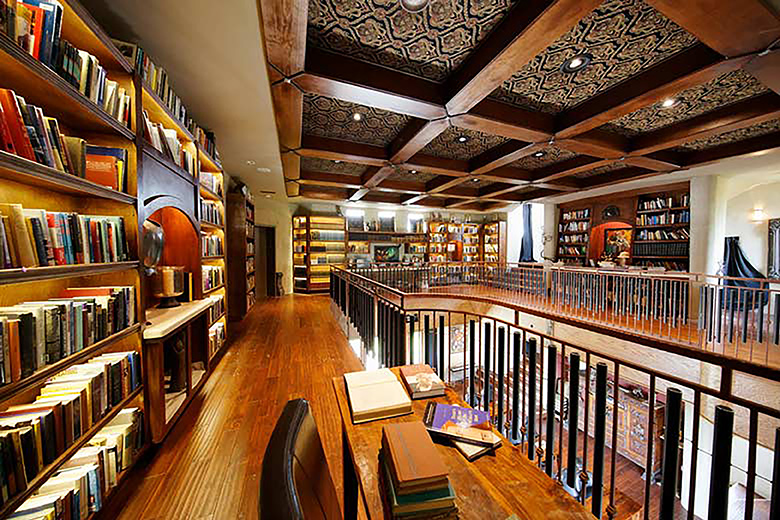
THE IMPOSSIBLE DREAM
from Man of La Mancha (1966) music by Mitch Leigh, lyrics by Joe Darion
To dream the impossible dream
To fight the unbeatable foe
To bear with unbearable sorrow
To run where the brave dare not go.
To right the unrightable wrong
To love pure and chaste from afar
To try when your arms are too weary
To reach the unreachable star.
This is my quest,
To follow that star
No matter how hopeless,
No matter how far
To fight for the right,
Without question or pause,
To be willing to march into Hell,
For a heavenly cause.
And I know if I’ll only be true,
To this glorious quest
That my heart will lie peaceful and calm,
When I’m laid to my rest.
And the world will be better for this,
That one man, scorned and covered with scars
Still strove with his last ounce of courage
To reach the unreachable star.
THE STAR DECK
At the top of our tower you’ll see a sword planted in the battlement, much like that sword a boy called Arthur saw planted in a stone long ago.
Our blacksmith-forged sword was given to Wizard Academy by Steve Rae, Dave Martin and Ron Love nearly a decade before we built the tower whose battlement now lifts it to the sky.
When you stand on the Laughlin Stone in the southern approach to the tower, that point of light you see above the hilt of the sword is the North Star.
You’ll find the cartoon that inspired the construction of the Tower in the Appendix of this book.
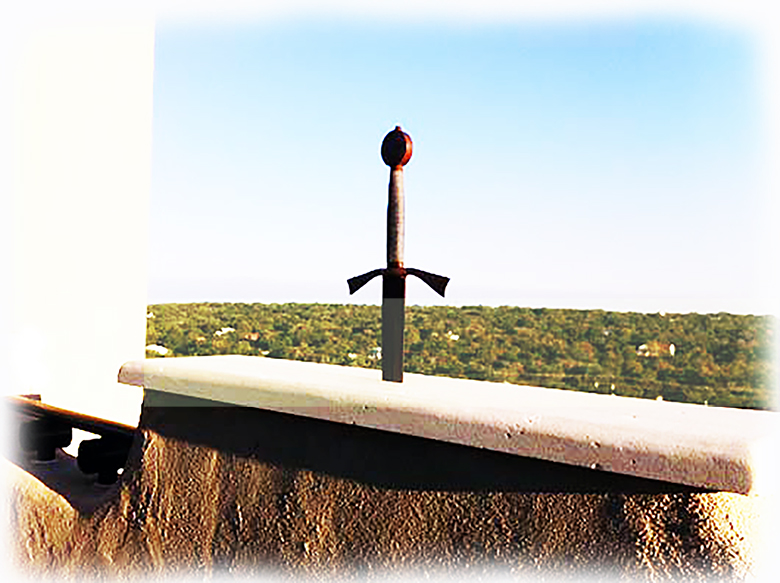
The North Star – Polaris – has served navigators of the northern hemisphere for thousands of years. Every other star moves across the sky as the earth revolves, but the North Star is perfectly aligned above the axis of the earth, making it the only star that does not move. It is the guiding light around which the whole earth revolves.
Each of us needs a beautiful dream, a guiding light, an unreachable star.
JOURNEYS OF IMAGINATION, ON THE STAR DECK
The highest point on the Wizard Academy Campus, indeed the highest point for a hundred miles, is the Stardeck atop our tower, a gift of David McInnis.
David asked a member of my staff if she knew of anything special he might buy as a gift for my fiftieth birthday. We had not yet completed the Tower.
“Roy showed us a statue in a magazine the other day that he said would be perfect for the top of the tower, but there was no way we could afford it.”
That staff member located the magazine and gave David the name of the statue, “Journeys of Imagination, by Gary Lee Price.”
Leaning against the pedestal of the statue is a little boy reading a book. At the top of that pedestal is the same boy, flying on those wings of paper he has folded into an airplane to carry him to worlds unknown.
Journeys of Imagination speaks of the marvelous trips we take in our minds when we read good books.
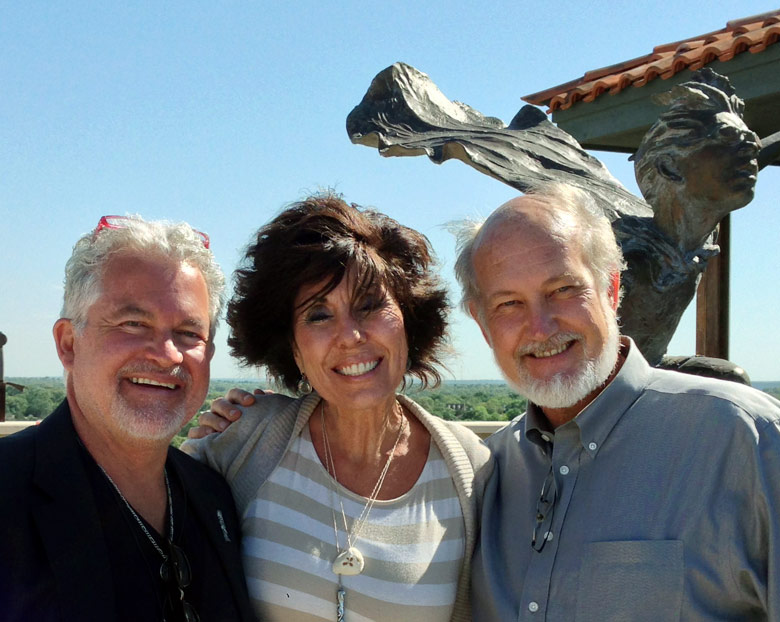
AS OUR STUDENTS WALK DOWN THE STAIRS TOWARD THE ART GALLERY
whose door leads to Jane DeDecker’s sculpture of The Old Man and the Sea, they can read Hemingway’s famous story of relentless determination.
The Old Man and the Sea was published in its entirety in the September 1, 1952 issue of Life magazine. More than 5 million copies of that issue were sold in 2 days and it won Ernest Hemingway the Pulitzer Prize in 1953 and the Nobel Prize in Literature in 1954.
Framed behind museum glass, that first printing of The Old Man and the Sea is available for students of Wizard Academy to read in a series of panels as they walk down the stairs toward the art gallery.
Those who read it in its entirety on the stairway are invited to sign the Captain’s Log in the office of the Chancellor behind the bookcase in the Library.
4. WALKING TO CHAPEL DULCINEA
Let us now begin our journey to Chapel Dulcinea from the parking lot of the Welcome Center where we will see:
THE BELL WALL
Our Bell Wall began with an old black and white photo of Mission San Gabriel in California. Its Moorish architecture came from Father Antonio Cruzado of Córdoba, Spain, who founded the mission on September 8, 1771.
THE BELLES OF LA MANCHA
are the women who paid for the construction of our wall.
STEVE RAE PLAZA
During the earliest years of the academy when the students had to stay in hotel rooms, Steve Rae would gather everyone after class, order lots of pizza, open several bottles of wine, open his guitar case and lead everyone in sing-alongs well into the night. Today Steve is one of the instructors in the academy’s Whiskey Marketing School.

Now pass through the portal from Steve Rae Plaza onto the:
RENEE’ JENKINS PATHWAY TO HAPPINESS
and you are on your way to Chapel Dulcinea.
Our campus makes it appear as though our school is knee-deep in cash, but the truth is dramatically otherwise. The first 8,000 brides to be married at Chapel Dulcinea walked a dirt path because the long sidewalk we needed to build was more money than we could afford.
It was Mother’s Day, 2014, when Dewey Jenkins of Charlotte, North Carolina, came to visit. I greeted him upon his arrival.
He shook his head and said, “Roy, I really messed up.”
“What have you done, Dewey?”
“I left so early for the airport that I didn’t have time to secure a Mother’s Day gift for Renee'”
“Take a walk with me.”
“Where are we going?”
“I’m going to show you what you’re going to do for Renee’.” Then I walked him over to where the dirt path began. “Brides have to walk a hundred yards in the mud to get to the chapel when it’s wet outside.”
“They shouldn’t have to do that,” Dewey said.
“As your gift to Renee’ this year, you should build a sidewalk for all those brides and we’ll call it The Renee’ Jenkins Pathway to Happiness.” Pointing to the portal post on the right, I said, “And right here will be a picture of Renee’ on her wedding day along with her best wishes to all the girls who walk this path.”
Dewey smiled and shook my hand and said, “Thank You.”
Yes, I’m a shameless fundraiser, but the larger truth is that Wizard Academy exists because of the generosity of friends like Dewey and Renee’ Jenkins and dozens of others like them.
The first thing you’ll find on that pathway is:
THE CANADIAN DIAMOND PAVILION
The architecture of the Pavilion tells an important story. Its 6,000-pound roof is held up by four circles of thin metal in the shape of two initials, “WA.” These initial-blazoned circles symbolize that Wizard Academy is held aloft and supported by its alumni. The iron balusters below its handrails are wiggly party streamers, symbols of the celebrations that happen here.
Let the party begin!
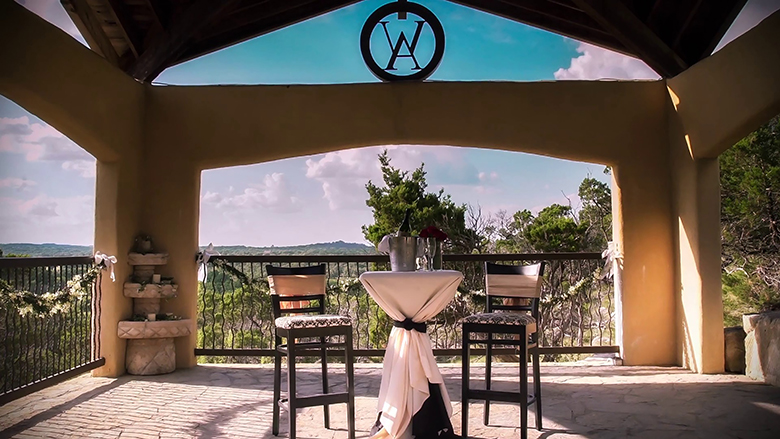
THE BROTHERS OF THE MUDD
In the same way that Into the Wind is aligned with The Old Man and the Sea, the Bell Wall is aligned with the Garden of Joy built by The Brothers of the Mudd.
The Belles paid for the Bell Wall.
The Brothers paid for the Garden of Joy.
The Brothers followed the leadership of TV producers Jim and Robb Mudd, who happily paid for:

GRACILLA, IN THE GARDEN OF JOY
I knew I had to secure that statue for Pennie’s Garden of Joy the moment I saw it.
“There’s no way this work was sculpted by an amateur,” I said. But the only name on the sculpture was “Aaron.”
The auctioneer knew nothing at all about it.
It took quite a lot to be the high bidder, but Jim and Robb Mudd cheerfully picked up the tab.
After it was purchased, I sent an email to every bronze foundry in America and included a photo of the elongated bronze woman with upraised arms. My hope was that one of them would remember casting it and would be able to put me in touch with the artist.
Finally, I received an email.
—–Original Message—–
From: Aaron Mosley
Sent: Saturday, Dec 1, 2007 5:15 PM
Subject: Fabulous Bronze SculptureDear Coordinator:
My name is Aaron Royal Mosley, a.k.a. Aaron. I am the creator and builder of the sculpture along the Academy’s path to Chapel Dulcinea, in the Garden of Joy. Named “Gracilla,” the sculpture is the result of a modest commission from Pastor Henry Garcia of the Blood of Christ Church in San Elizario, Texas.If you or someone at the Academy knows the circumstances that brought it to Austin and would share that information, I would be most appreciative. Naturally, I willingly share any additional information that I have.
As the author of the work, I humbly request appropriate recognition, or credit, as its sculptor.
Sincerely;
Aaron Royal Mosley
El Paso, TX 79903
When you arrive at Chapel Dulcinea, look down into the valley below and you will see Quixote gazing up at her from afar.
Dulcinea was his anima, the perfect woman who lived in his mind.
In reality, she was Aldonza Lorenzo, a common village girl with nothing special about her at all. But everything Quixote suffered was in her name and for her honor.
She was his guiding light and the energy that fueled his impossible dream.
“Her name is Dulcinea, her kingdom, Toboso, which is in La Mancha, her condition must be that of princess, at the very least, for she is my queen and lady, and her beauty is supernatural, for in it one finds the reality of all the impossible.”
– Don Quixote, 1605.
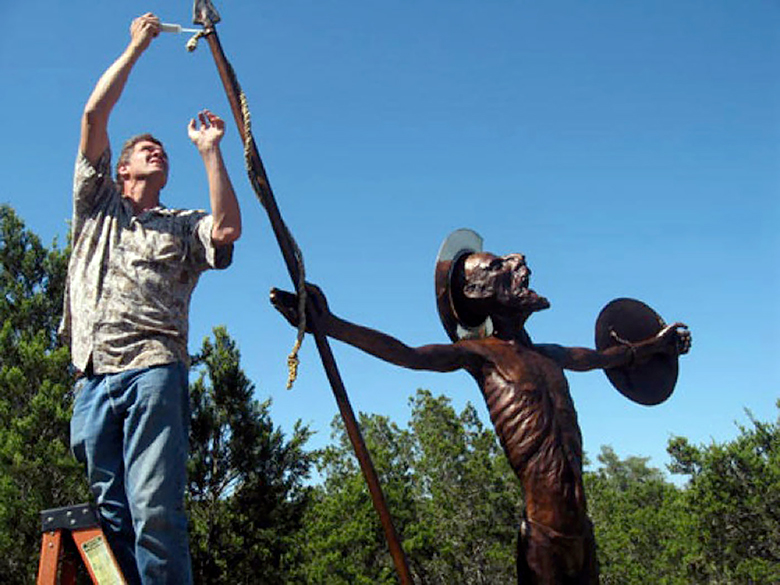
“The Lord said to Moses, ‘Make a serpent and put it up on a pole; anyone who is bitten can look at it and live.’ So Moses made a bronze serpent and put it up on a pole. Then when anyone was bitten by a snake and looked at the bronze snake, they lived.”
– Numbers 21:8
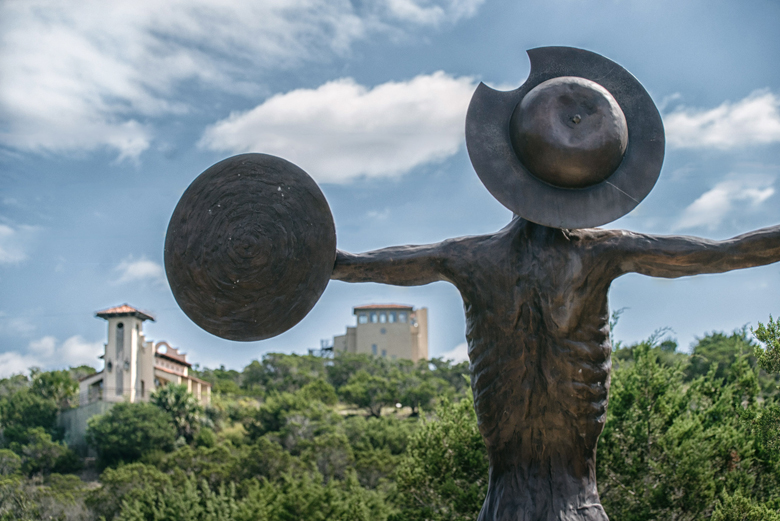
Don Quixote gazes at Dulcinea from the Valley of the Lost Boys. A serpent is twined around Quixote’s lance, and on the back of his shield is carved,
“Just as Moses lifted up the serpent in the wilderness, so must the Son of Man be lifted up, that whoever believes in him may have eternal life.”
– Jesus, in John 3:14-15
5. AT CHAPEL DULCINEA:
YOU ARE THE LIGHT THAT ENTERS THE DIAMOND
Viewed from above, the iron handrail that surrounds the base of the chapel forms the profile of the classic engagement ring diamond. The bottom point or “culet” of this glittering diamond is the point where the foundation of the chapel juts out the furthest from the cliff. Couples enter the chapel through the “table” of the diamond, just as sunlight enters a gemstone.
When that light is returned, it is made magnificent due to a transformation that happens while the light is within the stone.
When the two of you stand together in Chapel Dulcinea, you are the sunlight that has entered the diamond, and when you step out again, you will likewise be transformed into something magnificent.
THE BALUSTRADE BELOW THE IRON HANDRAIL
that outlines the engagement ring diamond has the profile of a pregnant female, signaling that this is a place where new life begins.
THE ANTIQUE GOTHIC DOOR
leading into the bell tower is 10 and 1/2 feet tall and allows Dulcinea’s newlywed couple to step into the bell tower and pull together to announce their union to the world. This happy pair of partners will be pulling together for the rest of their lives.

Chapel Dulcinea’s thick walls communicate safety and protection.
Chapel Dulcinea’s high ceiling speaks of majesty and inspires big thoughts.
Chapel Dulcinea’s tiny footprint whispers intimacy.
Chapel Dulcinea’s 12 upper windows speak of a cycle completed, a circle.
Twelve is the number of the circle.
12 months for the earth to circle the sun,
12 hours for the hour-hand to circumnavigate a clock,
12 tribes of Israel,
12 apostles of Jesus,
12 constellations in the zodiac.
Marriage completes yet another circle, as seen in
MY HEART IS IN YOUR HANDS.
You’ll find it located beyond the chapel, of course.
CHAPEL DULCINEA WAS BORN ON A SATURDAY MORNING IN THE AUTUMN OF 2004
“I’m going to buy a bell. A big, expensive bell.”
“Why?”
“I’m not sure.”
“Where are you going to put this bell?” Pennie asked.
“I don’t know.”
“Call Marley.”
Marley Porter is our architect. I dialed his number. “Marley, it’s Roy. I’m going to buy a bell. A really big bell. Where will we put it?”
“We haven’t planned any buildings where a bell would be appropriate.”
“What kinds of buildings get to have bells?”
“Ideally, a chapel.”
“Design us an open-air wedding chapel, Marley. We’re going to let couples get married there for free. And we’re going to call it Chapel Dulcinea.”
“I can already see it in my mind and I know exactly where it should go. Roy, I’m getting goose-bumps.”
“Meet us at the campus, Marley.”
Start to finish, that whole conversation took less than 2 minutes.
Wizard Academy’s free wedding chapel – Chapel Dulcinea – was the first building completed on the campus.

DURING CONSTRUCTION
Pennie made a last-minute decision to raise the ceiling and add those famous 12 upper windows, then she lengthened the cedar beam-struts that hold up the clay tile roof, thereby creating “the ribs of Jonah’s great fish.”
Remember the story? Jonah was on the ocean when a storm came.
Thrown overboard, he is swallowed by “a great fish.”
From inside the fish Jonah prayed to the Lord his God. He said:
“In my distress I called to the Lord, and he answered me.
– Jonah, Chapter 2
From deep in the realm of the dead I called for help,
and you listened to my cry…
When my soul fainted within me,
I remembered the Lord,
And my prayer went up to You…”
So the LORD spoke to the fish, and it spit Jonah onto dry land.

CHAPEL DULCINEA IS MADE FROM
Earth – The Chapel’s floor, benches, walls and roof tiles are all made from natural earth materials.
Wind – Extending out into the atmosphere from the edge of a cliff, a gentle breeze is always stirring.
Fire – Eighteen natural gas lanterns send flickering flames – a dance of light throughout the chapel’s interior.
Water – A recirculating spring gushes from the side of the Chapel’s foundation.
“But when they came to Jesus and saw that He was already dead, they did not break His legs. But one of the soldiers pierced His side with a spear, and immediately blood and water came out. And he who has seen has testified, and his testimony is true; and he knows that he is telling the truth, so that you may believe.”
– John’s Good News, chap. 7
EIGHTEEN GAS LIGHTS
In Hebrew, every letter is also a number.
Chai, the Hebrew word for life, is comprised of two Hebrew letters, Chet and Yod. Chet carries the numerical value of 8, and Yod is 10, for a total of 18. Consequently, the 18 flames of Chapel Dulcinea’s gas lights push back the darkness with a shout of “Life” each day at sundown.
BUT WAIT, THERE IS A SECOND DIAMOND. A BASEBALL DIAMOND.
Home plate, of course, is in the corner of the old homeplace opposite the entrance to Chapel Dulcinea. Extend the walls of the old homeplace to the handrails of the foundation on which Chapel Dulcinea sits, and you will see a baseball diamond.
Walk the bases and you’ll find a different message inscribed on each. These messages correspond to the 4 stages of transformation:
1. Recognition of need
2. Willingness to pay the price to be changed.
3. Turning of attention away from self, toward others.
4. Living at a higher level.

Life is a series of transformative journeys.
Throughout our lives, each of us touches those 4 bases again and again as we continue to become who we are.
“We shall not cease from exploration
– T.S. Eliot, from Little Gidding, last of the Four Quartets
And the end of all our exploring
Will be to arrive where we started
And know the place for the first time.”
“A man travels the world in search of what he needs and then returns home to find it.”
– Carlos Ruiz Zafon, Shadow of the Wind
This next passage is from Bart Giamatti, Professor of Comparative Literature, President of Yale University, Commissioner of Major League Baseball:
“There is no great long poem about baseball. It may be that baseball is itself it’s own great long poem. This had occurred to me in the course of my wondering why home plate wasn’t called fourth base. And then it came to me: Why not? Meditate on the name, for a moment, ‘home.’ Home is an English word that is virtually impossible to translate into other tongues. No translation catches the associations, the mixture of memory and longing, the sense of security and autonomy and the accessibility and the aroma of inclusiveness, of freedom from wariness. They cling to the word ‘home’ and are absent from ‘house’ or even ‘my house.’ Home is a concept, not a place. It is a state of mind where self-definition starts. It is origins: the mix of time and place and smell and weather wherein one first realizes one is an original. Perhaps like others, especially those one loves, but discreet, distinct, not to be copied. Home is where one first learned to be separate. And it remains in the mind as the place where reunion, if it were ever to occur, would happen… All literary romance, all romance epic, derives from the Odyssey and it’s about going home. It’s about rejoining – rejoining a beloved, rejoining a parent to child, rejoining a land to its rightful owner or rule. Romance is about putting things right after some tragedy has put them asunder. It is about restoration of the right relations among things. And going home is where that restoration occurs because that’s where it matters most. Baseball is, of course, entirely about going home. It’s the only game you ever heard of where you want to get back to where you started; all the other games are territorial – you want to get his or her territory – not baseball. Baseball simply wants to get you from here back around to here.”
THINKING BIG THOUGHTS IN A THIN PLACE
When you sit alone in the chapel at night, it causes you to think big thoughts. Marley Porter says this is due to being in “the space in the middle.” I think I know what he meant.
During his visit here, Linford Detweiler from the band Over the Rhine said, “This is a thin place.”
“What do you mean?” I asked.
“This world is one place,” he said, “and the next world is another. A thin place is where those two worlds are not far apart. And you can feel it.”
Meike flew to Austin from Germany to attend the Magical Worlds Communications Workshop. When I mentioned Dulcinea’s ability to trigger big thoughts, she decided to put it to the test. Here is what she wrote when she returned to Germany.
“I was standing at Chapel Dulcinea and I waited until everyone had left. Standing at the edge it felt like flying. I couldn’t see the barrier, didn’t know how deep the valley was, above me the stars. Yes, you can’t help it, you have to think deep thoughts there. And amazing enough you feel somehow connected to what surrounds you. It made me cry that night. All kinds of memory popping into my mind. A place of commitment… Before I left I started singing.”

6. EXPLANATION POINT, and MY HEART IS IN YOUR HANDS
MY HEART IS IN YOUR HANDS
The fourth of our four DeDecker sculptures speaks of the circle that springs into existence at the moment of commitment. Two people unite and become one. It is a moment of musterion. It is a moment of sacramentum. You can find it just past Chapel Dulcinea, near Explanation Point.
EXPLANATION POINT
You’ll find the explanation of Wizard Academy’s name on a pair of bronze plaques mounted on a stone base just past Chapel Dulcinea.
John Milton, having just turned 21 in 1629, stayed up all night on Christmas Eve to write “On the Morning of Christ’s Nativity.”
This is the final stanza. You’ll find it on the second plaque:
“See how from far upon the eastern road
The star-led wisards haste with odours sweet:
O run, prevent them with thy humble ode,
And lay it lowly at his blessed feet;
Have thou the honour first thy Lord to greet,
And join thy voice unto the angel quire,
From out his secret altar touch’d with hallow’d fire.”

Obviously, Milton was speaking of the wise men (wise-ards) described in Matthew chapter two.
Not only did these wisards know what that star meant, they also knew what gifts to bring:
(1.) Gold, the gift given to a king,
(2.) Frankincense, burned in the temple as an offering to God, and
(3.) Myrrh, resin harvested from the skin of the commiphora tree, used to embalm the bodies of the dead.
They knew this baby
(1.) was king,
(2.) was God, and
(3.) was going to die.
And they came to worship him.
Exactly 18 years before Milton wrote about “the star-led wisards,” England’s King James commissioned a translation of the Bible that would forever be known as the 1611 King James Version. This is the passage you’ll find on the plaque to the left of Milton’s “wisards” poem:
“Now when Jesus was born in Bethlehem of Judaea in the days of Herod the king, behold, there came wise men from the east to Jerusalem, saying, ‘Where is he that is born King of the Jews? for we have seen his star in the east, and are come to worship him…’ And when they were come into the house, they saw the young child with Mary his mother, and fell down, and worshipped him: and when they had opened their treasures, they presented unto him gifts; gold, and frankincense and myrrh.”
– Matthew, Chapter 2, King James Bible, translated in 1611
Will anyone have enough curiosity to read the plaques at Explanation Point and understand their meaning?
I don’t know.
But I hope so.

7. ON THE OTHER SIDE OF THE BELL WALL IN THE VALLEY OF THE LOST BOYS, DOWN BELOW THE CHAPEL
(Passage through the Bell Wall to the western part of the campus is prohibited to all but students currently in class at Wizard Academy.)
These are the buildings and gardens that lie beyond that wall:
SPENCE MANOR
Pass through the arch and you’re in the Zubiate Courtyard of the Manor. Walk through the front door and you’re in a Spanish hacienda filled with artifacts from the Old West. This student mansion boasts a kitchen, a dining room, a conference room, a living room, 4 bedrooms and 3 baths. Spence Manor is open only to currently enrolled students of Wizard Academy.
THE CANTILEVERED GYM
Why build a gym that looks like every other?
The students of Wizard Academy chose a gym that looks like a diving board extending off the edge of a cliff. What a view!

QUIXOTE’S ROCINANTE and STEINBECK’S TRAVELS WITH CHARLEY
Travels with Charley was John Steinbeck’s diary of a journey to see America with his dog in a 1962 GMC pickup-with-camper he called “Rocinante.” He was awarded the Nobel Prize in Literature later that year.
“John Steinbeck saw Don Quixote as a symbol of himself, and the novel’s morally arid time as a mirror of mid-twentieth-century America. Thus, Steinbeck traveled to Spain and La Mancha in 1954 out of a special affinity for the place, and began his journey to rediscover the soul of America in a camper he affectionately christened Rocinante.”
“The fruits of his journey – Operation Windmill as he called it – eventually found expression in Travels with Charley.”
“To the very end, the romantic ideals expressed in the work of Miguel de Cervantes stoked the moral and artistic imagination of John Steinbeck.”
– Stephen K. George, A John Steinbeck Encyclopedia, p. 55

Students from Wizard Academy occasionally ask to sleep in Rocinante II, our 1962 GMC pickup-with-camper virtually identical to Steinbeck’s Rocinante. You’ll find it next to the cantilevered gym on Gallagher Lane.

THE MENCH BENCH
is an artistically carved iron fire-pit surrounded by a vast, curved bench on which a large number of people can be seated. It is an after-dark place for presentations and songs. The word Mensch, in Yiddish, is “someone to admire and emulate, someone of noble character.”
THE LENHARD-MURRAY AMPITHEATER
will be constructed as an expansion of the Mench Bench. It will include a stage with lighting and additional rows of upper seating on the hillside that rises above it.
BAG END,
the Home of Bilbo and Frodo Baggins will be constructed in the Shire, a hidden valley just west of the Mench Bench. It will be used as an additional guest room during classes at Wizard Academy and will be available as a rental on the weekends.
BORGES, THE TIGER
strides along the cliff to your left as you approach Engelbrecht House on Gallagher Lane.
Lions represent challenges that come from outside you, but the tiger represents that defiant determination that comes from within. Tigers are solitary creatures.
Our Tiger is named Borges. (Boar-hes)
Argentinian writer Jorge Luis Borges spent countless hours thinking about tigers. As he grew older, Borges’ eyesight cruelly abandoned him, but never his faithful tiger.
“And now that I am blind, one single color remains for me, and it is precisely the color of the tiger, the color yellow.”
And of his days walking among us, he had only this to say:
“Time is the substance I’m made of. Time is a river that sweeps me along, but I am the river; it is a tiger that tears me apart, but I am the tiger; it is a fire that consumes me, but I am the fire. The world, unfortunately, is real; I, unfortunately, am Borges.”
THE GARDEN OF PLAY
is where an elf in a rubber-band-powered airplane swoops down with a croquet mallet to play Garden Gnome Polo. Our airborne elf is the work of that famous British sculptor, David Goode.
THE JEFF MORRIS WORLDWIDE INVITATIONAL BOCCE BALL COURT
occupies a garden outside the upper entrance to Engelbrecht House. Now retired, Jeff edited and designed the Wizard of Ads trilogy of books that caused thousands of people to want to travel to Austin to meet the wizard.
Jeff loves bocce ball and we love Jeff. Hence, the bocce ball court.
The Wizard of Ads trilogy, published by Bard Press, was a series of New York Times and Wall Street Journal bestselling books.
Ray Bard served as our first chairman of the board when Wizard Academy was founded. An oil painting of Ray dressed as Don Quixote hangs in a celebrated niche among the books on the library catwalk of the Tower.

ENGELBRECHT HOUSE
Deep in the valley (See chap. 2) is Engelbrecht House, a place of relationship and rest. A plaque in the courtyard tells the story:
Engelbrecht is German for “Angel-broken.”
“So Jacob was left alone, and a man wrestled with him till daybreak. When the man saw that he could not overpower him, he touched the socket of Jacob’s hip so that his hip was wrenched as he wrestled with the man. Then the man said, “Let me go, for it is daybreak.”
But Jacob replied, “I will not let you go unless you bless me.”
The man asked him, “What is your name?”
“Jacob,” he answered.
Then the man said, “Your name will no longer be Jacob, but Israel, because you have struggled with God and with men and have overcome.”
Jacob said, “Please tell me your name.”
But he replied, “Why do you ask my name?” Then he blessed him there.
So Jacob called the place Peniel…” (meaning Face of God.)
– Genesis Chapter 32
It is during the night that we are broken by angels and see the face of God.
May it be so unto you.
Good night.
ANGEL, BROKEN
Engelbrecht House is a place of rest, a place for the unconscious mind to do its work. Each of the 14 rooms in Engelbrecht House provides rest for an artist’s broken angel, with 3 more to be found in the kitchen.
1. Sleeper, Lost in Dreams, James Christensen
2. The Other Wing
3. Wounded Angel
4. Quixote Shadow Angel, Thomas Moreau, (1965)
5. Descending Night, Adolph Alexander Weinman (1915)
6. Buccaneer’s Wooden Angel (1800’s)
7. Engelbrecht Angels of Music
8. Marilyn Monroe, on the morning her body was discovered
9. Sue Lyon was14 years old when she made Lolita (1962)
10. Lillian Leitzel dreamed of flying.
11. Jacob Wrestles with an Angel, Rembrandt (1659)
12. Hollywood’s Broken Angel, Lillian Entwistle, “Peg” to her friends.
13. Graffiti Angel. Broken. by Banksy
14. And There Was A Great Cry In Egypt, by Arthur Hacker, (1897)
15. Iron Angel, from a junk shop on West 6th Street
16. Angel with Bandaged Ear, James Christensen
17. The One-Winged Angel of Liberace, from his home in West Palm Beach

THE FOUNTAIN AT ENGELBRECHT HOUSE
The fountain at Engelbrecht House represents the waterline of “a thin place” since it begins at a low level but rises ever higher until it transcends the ceiling and reaches into a higher dimension. (See Chapter 2) The clues to understanding this fountain can be found if you:
1. Stand at the bottom of the stairway that leads from the courtyard to the upper plaza. The plaque reads:
JACOB’S STAIRWAY
“When Jacob reached a certain place, he stopped for the night because the sun had set. Taking one of the stones there, he put it under his head and lay down to sleep. He had a dream in which he saw a stairway resting on the earth, with its top reaching to heaven, and the angels of God were ascending and descending on it.”
– Genesis 28
2. On the bridge that connects the upper sidewalk to the upper plaza of Engelbrecht House, we read a second plaque:
ENOCH’S DRAWBRIDGE
“Enoch walked with God; then he was no more, because God took him away.”
– Genesis 5
“By faith Enoch was taken from this life, so that he did not experience death; he could not be found, because God had taken him away.”
– Hebrews 11
There are no chains to raise this drawbridge.
The way is always open.
– John 14:6
When you stand in the courtyard of Engelbrecht House, you are “below the waterline” of Engelbrecht’s multi-tiered fountain. That fountain then rises through the floor above, creating a second waterline of glittering liquid a few feet higher than the upper plaza. Whether you stand in the lower courtyard or the upper plaza, you are always “below the waterline.”
The courtyard represents the earth.
The upper plaza represents the realm of God.
Prayer is the water that rises through the ceiling above the courtyard to sparkle in the sunlight of the upper plaza.
God’s answers to prayer are represented by the sparkling water that falls back down.
THE VILLAGE OF THE LOST BOYS
Go to sleep in one of these six adorable bungalows in The Valley of the Lost Boys and you will wake up in the world of Peter Pan. According to J.M. Barrie, the Lost Boys are a tribe of “children who fall out of their prams when the nurse is not looking.” Those who are not claimed within seven days are collected by the faeries and flown to Neverland.
There are no Lost Girls because, as Peter explains, “girls are much too clever to fall out of their prams and be lost in this manner.”
With two beds in each unit, the Village of the Lost Boys is available to rent along with the Long House (with seating for up to 50 people.)

8. THE ENCHANTED EMPORIUM WELCOME CENTER, THE CROWDED BARREL DISTILLERY, AND THE GRAPES & GRAIN OPEN-AIR BAR
THE ENCHANTED EMPORIUM WELCOME CENTER
is where you’ll find the answers to your questions, the snacks to satisfy your hunger, and the drinks to slake your thirst. Look around and you’ll see:
THE SPIRIT OF ECSTACY (1911)
The statue that became the official Rolls Royce hood ornament features a woman leaning into the wind. Sculptor Charles Sykes called her,
“A graceful little goddess who has selected road travel as her supreme delight and alighted on the prow of a Rolls-Royce motor car to revel in the freshness of the air and the musical sound of her fluttering draperies.”
The Spirit of Ecstasy has adorned the hood of every Rolls Royce since 1911. Her image has evolved different variations over the years, but ours is the original. Sadly, the model for the sculpture, Eleanor Velasco Thornton, was killed on December 30, 1915, when the The SS Persia was torpedoed by a German U-boat south of Crete.

THE VERANDA ROOM
is in the West Wing of the Welcome Center, perfect for gatherings of up to 50 people. A hidden screen drops down at the touch of a button and the built-in projector fills it with whatever you want your guests to see.
Walk up that gorgeous staircase to the loft that overlooks the room, then out that side door to:

JULIET’S BALCONY
“Romeo, Romeo, wherefore are thou, Romeo?”
He’s waiting for you down in the private courtyard below, in a beautiful little walled garden. Have you ever seen iron gates as elegant as those? They open onto the path that leads to the chapel.
Do you see that little building over there? That’s the
GROOM’S DRESSING ROOM
where he can hang out with his groomsmen.
At the opposite end of the Welcome Center is the
BRIDE’S CHANGING ROOM
equipped with everything she needs.
Isn’t she gorgeous? Do you see that tall, triangular window?
Pull back those curtains and you’ll see the world-famous…

CROWDED BARREL DISTILLERY AND
THE FANG & FEATHER TASTING ROOM
with its multi-tiered decks and spiral staircase. If it looks familiar to you, that’s because you’ve seen it on one of the daily episodes of The Whiskey Vault. Did you know our show is the #1 whiskey review show on YouTube?
So now you know how the smallest distillery in Texas became big news around the world.
It’s called The Crowded Barrel because the whiskey recipes they use are crowd-sourced from The Whiskey Tribe, a community of whiskey aficionados who vote on every step of the process. We make the whiskeys they design.
Show up on any Friday, Saturday, or Sunday and you’ll meet people who have traveled from all over the world just to take a selfie at The Fang and Feather Tasting Room.
And the whiskey they serve is amazing.
That adorable little building next to the Fang and Feather is…

THE GRAPES & GRAIN, A BEER & WINE BAR
serving all the same beverages you’ll find inside the Enchanted Emporium, plus several types of draft beer in a relaxing outdoor space beneath a live oak tree that is older than America.
In the life of a southern live oak, 1776 wasn’t that long ago.
9. ON THE EAST SIDE OF THE CAMPUS: TUSCAN HALL, TUSCAN COURT, TUSCAN TERRACE, SUNPOP STUDIOS, AND THE HOUSE OF 10 DOORS
TUSCAN HALL
Walk through that arched portal at the eastern edge of the limestone parking lot and you’ll enter the lush gardens reminiscent of an estate in Tuscany. You hear the roar of a waterfall below your feet. Follow the elevated sidewalk to your right and you can descend to the pool below.
Yes, this is another of those symbolic waterlines. (See chapter 2)

YOU LEFT THE HECTIC WORLD BEHIND YOU when you stepped through that portal from the parking lot. And then you descended down to where the waterline symbolically separates the too-busy conscious mind from the magical world of the unconscious below. Step through those double doors and you’ll see the floor of
TUSCAN HALL
is two steps below that waterline. Take those last two steps and prepare to be amazed. This is a place of art and music and laughter, where the spirit is refreshed and the soul is encouraged.
TUSCAN COURT
is an elevated garden reclaimed from a sharply declining hillside with the help of a curved retaining wall and several dump-truck loads of dirt. Bordered by the limestone parking lot on one side and the retaining wall on the other, this beautiful green meeting space was designed for large, outdoor gatherings. It is also the perfect place for kids to play when their parents are gathered in Tuscan Hall.
AN ITALIAN MARBLE GAZEBO
is the focal point of Tuscan Court because her garden politely asked for it and Princess Pennie always listens to her gardens.

GARDENIA, GUARDIAN OF THE GARDEN
Krista Ellis-Smith saw our 5-foot bronze fairy smelling a flower in the garden of Tuscan Court and said to herself, “This is the fairy guardian of the garden and her name, of course, is Gardenia.” Krista sent us an email informing us of the fairy’s name and that was that.
TUSCAN TERRACE
is the garden on the north side of Tuscan Hall. After seeing the garden on the south get a white marble gazebo simply by asking the Princess, Tuscan Terrace was emboldened to ask for a whole list of things:
1. A bridge across the dry creek
2. 200-year-old heavy iron fencing from London, England
3. Multiple tiers of outdoor tables with a bar made of reclaimed driftwood
4. A large garden folly featuring a 350-year-old Spanish fortress door, and
5. A miniature cathedral with a gothic stained-glass window from 1887.
THE HOUSE OF 10 DOORS
is where we hide the luxurious private suite available for overnight rental. The other 5 doors open into storage closets and the offices of geniuses.
SUNPOP STUDIOS
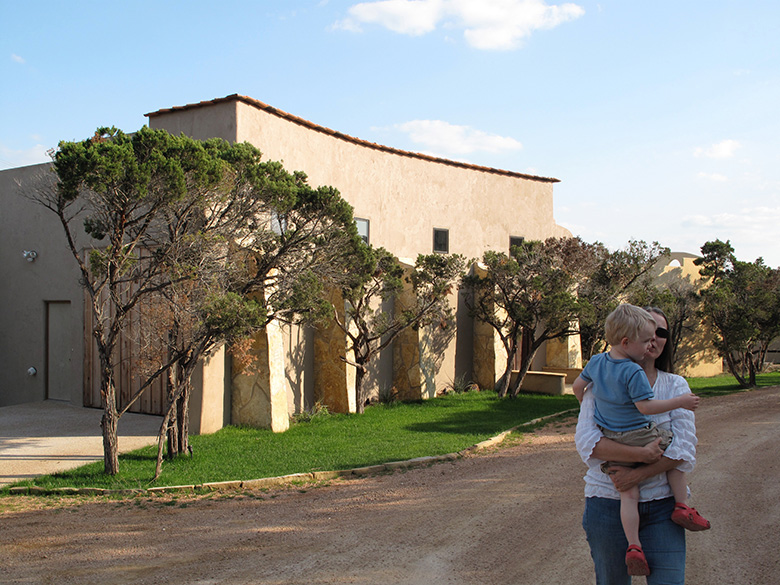
ADDENDUM

The literary world has been drawn to Don Quixote for more than four centuries. It is the most widely read book on earth, second only to the Bible.
John Steinbeck said, “A story has as many versions as it has readers. Everyone takes what he wants or can from it and thus changes it to his measure.”
Perhaps I find in Don Quixote only that which I bring to it, but I’ve always believed that Cervantes echoed the Bible intentionally.
Consider the following:
1. Jesus is “knighted” by John the Baptist in the river Jordan. “Behold the (sacrificial) Lamb of God who takes away the sin of the world.” John the Baptist has no authority to do this.
An innkeeper likewise “knights” Don Quixote.
He, too, has no authority to do this. (Ch. 3)
2. Jesus says, “He has sent me to proclaim freedom for the prisoners and recovery of sight for the blind, to release the oppressed…”
Don Quixote also speaks of “aiding those who are oppressed.” (Ch. 22)
3. Jesus sees death as a giant that must be defeated.
Quixote sees the windmill as a giant that must be defeated. (Ch. 8)
4. When Jesus challenges death, he is lifted on the wooden arms of a cross and returned, broken, to the ground.
When Quixote challenges the windmill, he is lifted on its wooden arms and returned, broken, to the ground. (Ch. 8)
5. Jesus wears a crown of thorns and everyone thinks he looks ridiculous.
Quixote wears a barber’s basin and everyone thinks he looks ridiculous. (Ch. 21)
6. Jesus is rejected by people he has set free.
Quixote is rejected by people he has set free. (Ch. 22)
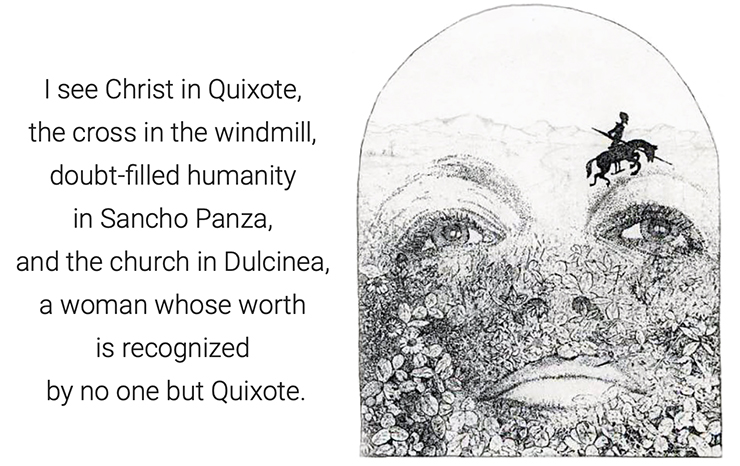
7. Humanity vacillates: Is Jesus who he claims to be, or is he delusional?
Sancho Panza vacillates: Is Quixote who he claims to be, or is he delusional?
8. Jesus promises his followers a kingdom.
Quixote promises Sancho Panza a kingdom, then fulfills that promise when he makes him governor of an island. (The promise is made in Part One, Ch. 7, fulfilled in Part Two, Ch. 42)
9. Jesus presides at supper with 12 guests in an upper room.
Don Quixote presides at supper with 12 guests in an upper room. (Chap. 37-38)
10. Jesus allows himself to be locked in the cage of Death in order that he might be united with his beloved, the church.
Quixote allows himself to be locked in a cage in order that he might be united with his beloved, Dulcinea. (Ch. 46)
As I confessed, perhaps I’m seeing Christ in Quixote when Cervantes did not. But my friend Massimiliano Giorgini agrees with my beliefs.
He claims Cervantes did all of this on purpose.
Massimiliano Giorgini is a code-breaking genius that was recruited by both of America’s most famous intelligence-gathering organizations, each of which is known by 3 initials. He is also a highly regarded Quixote scholar whose writings have been published in the scholarly journals of The Cervantes Society, a group of scholars that includes many of the heads of the Departments of Spanish Literature from important colleges and universities across the Western Hemisphere. Massimiliano first came to Wizard Academy in 2009 with his mentor, Dr. Howard Mancing, a world-renowned Quixote scholar and the author of The Cervantes Encyclopedia.
Here’s a quick overview of what Massimiliano Giorgini discovered:
Cervantes wrote Don Quixote in 1605 when the Spanish Inquisition was in full swing. Anyone caught with a copy of the New Testament translated into Spanish by Francisco de Enzinas would immediately be put to death. Indeed, Julián Hernández had already been tortured for 3 years and burned at the stake for owning such a Bible, along with more than 100 other people during the 17 years prior to 1605.
When Cervantes wrote Don Quixote, he was basically saying, “I own a copy of the forbidden Spanish Bible, and I am looking at it right now!”

This is fascinating stuff, but Massimiliano is far from done.
“Let’s take a look at the complex image within that forbidden New Testament translated into Spanish by Francisco de Enzinas. At first glance we see a tall, slender man wearing a strange piece of headgear – much like Quixote – and a shorter, heavier man with the words ‘This is Sancho’ written next to him in Spanish.”

In his 2014 TED-X video, Massimiliano tells us that in Part Two of Don Quixote,
“Quixote meets a character who tells him that a book has already been written about Quixote’s own adventures! Quixote responds by saying, ‘Whoever that ignorant writer was, he must be like the painter who was so bad that he would paint a rooster and then have to write Rooster next to it in Visigothic letters. And so it will be with my story, which will require a commentary in order to understand it.’”
Massimiliano says when he read that passage,
“This triggered a memory of the famous Jesus fish, or ICTHYS. This is a way early Christians used to communicate their beliefs to one another during the time of the Roman persecutions. Essentially, the letters alongside the fish spell ‘FISH’ in Greek while each individual letter forms the acrostic, ‘Jesus Christ, Son of God, Savior.”
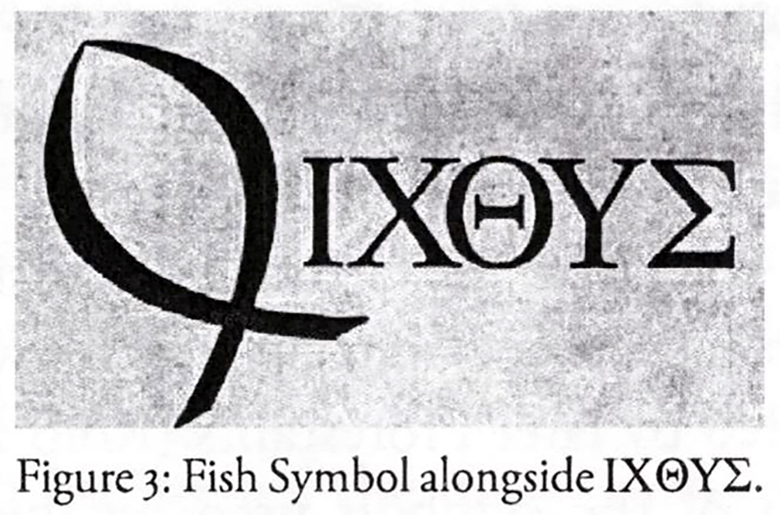
“And if you see the fish as the letter Q, this same acrostic spells QUIXOTE in Visigothic letters… And it turns out that the word gallo, which means ROOSTER in Spanish, is also the name of a fish known as ‘CHRIST’S FISH’ in Greece.”
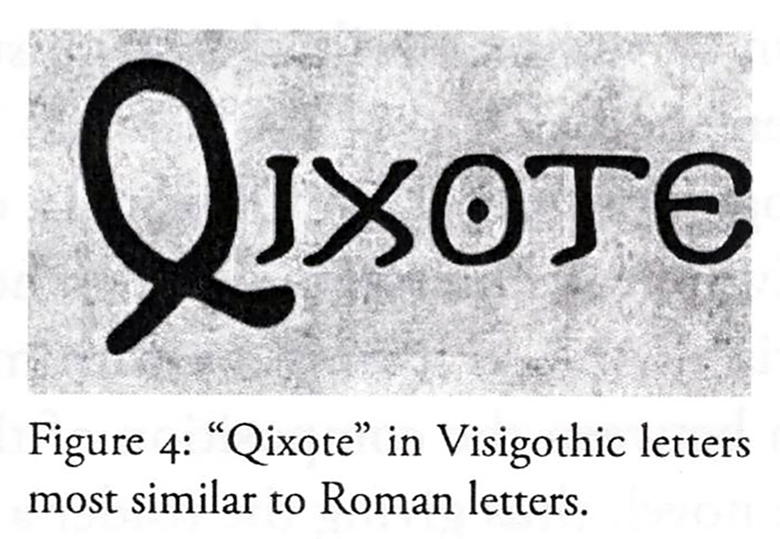
From the pages of Don Quixote de La Mancha, Miguel de Cervantes chose to shout, “I own a copy of the forbidden Spanish New Testament and I am looking at it right now!”
Massimiliano Giorgini gathered plenty of evidence to prove it.
Cervantes disagreed with the Spanish Inquisition and shouted his defiance of it from the pages of the most successful book of fiction ever written.
But it was a shout that no one would hear for more than 400 years.
Massimiliano, on behalf of Miguel de Cervantes, let me say “Thank You.”
His shout across the centuries has at last been heard.
– Roy H. Williams

TAKE YOUR INSPIRATION FROM WHEREVER YOU FIND IT, NO MATTER HOW RIDICULOUS.
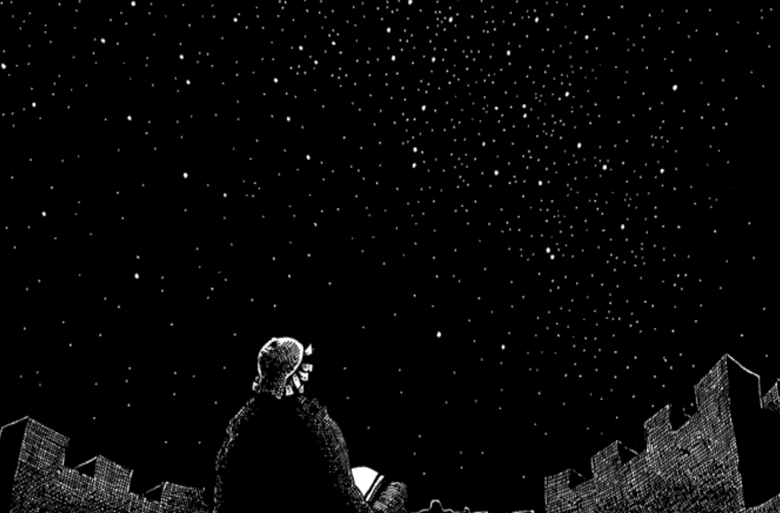
1999 – I have no idea who created the image, but there it was: a boy sitting on a tower at night with a book in his lap, looking up at the stars, contemplating the meaning of life.
I looked at that cartoon image and instantly knew that Pennie and I would someday build a tower with a star deck where people could gather late at night and look at the stars and think big thoughts.
High ceilings inspire big thoughts.
The stars are painted across a very high ceiling.
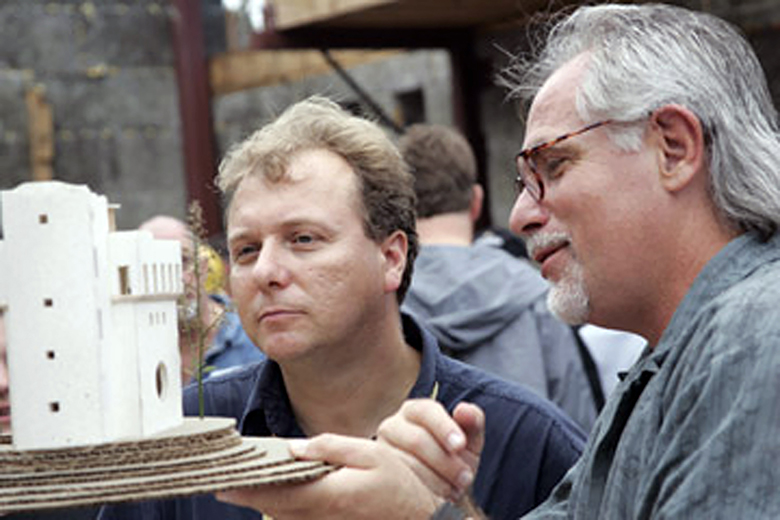
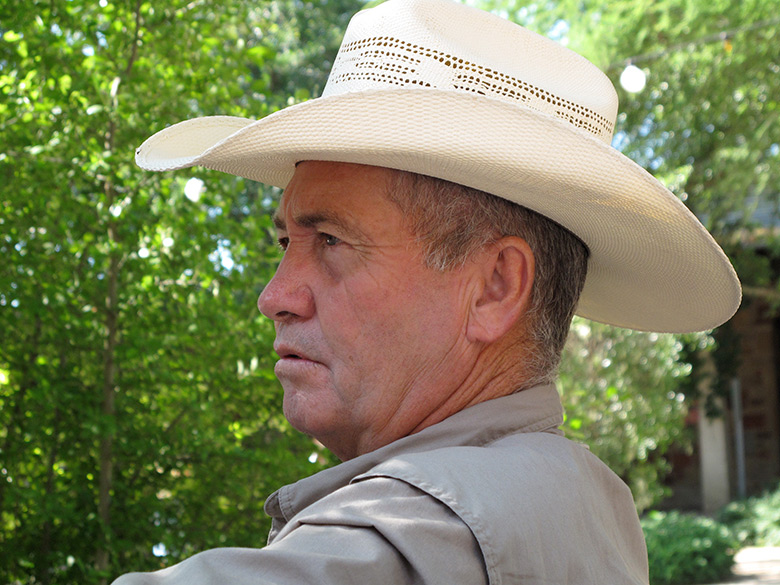


Thank You
for believing in
our impossible dream
and helping to bring it into
the bright light of day.
You are amazing.
Roy and Pennie Williams